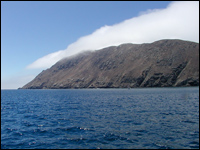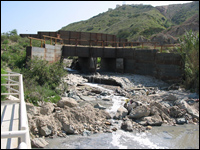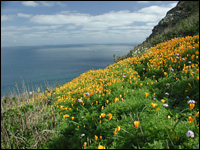Serge Dedina is cofounder and executive director of WiLDCOAST, an international conservation team located in Imperial Beach, Calif., just north of the Mexico-U.S. border. He is the author of Saving the Gray Whale, a book based on the three years he lived in the gray-whale lagoons of Baja California.

Friday, 15 Oct 2004
IMPERIAL BEACH, Calif.
From the bluff overlooking Playas de Tijuana and the rusting iron fence that juts out in the Pacific separating Mexico from the United States, the Coronado Islands appear as a mirage. Only a short nine miles offshore from the western end of California and the beginning of Mexico, the three sister islands an area where elephant seals, great white sharks, and thousands of nesting seabirds make their home.

A lot o’ Coronado.
Photo: Aaron Quintanar/WiLDCOAST.
Sadly, since ChevronTexaco just received the permission of Mexico’s Environment Ministry to build a $700 million liquefied natural gas (LNG) terminal 600 yards offshore from the islands, the wildlife of the Coronado Islands might not have much time left.
As I peer out over the ocean from the dirt bluff at the edge of the grassy picnic area of the now-abandoned Border Field State Park, I cover my left eye and turn my head to the right. From the U.S. side of my face, I only see the islands and the quiet empty space of the Tijuana Estuary National Wildlife Refuge and the whitewater of the Sloughs, my favorite surf break, where dolphins are more common than people.
If the world’s largest colony of the nocturnal and threatened Xantus’s Murrelet gulls can thrive on the Coronado Islands within an easy flight of the world’s biggest storm drain, the Tijuana River — a concrete channel turned natural river mouth that routinely spits out up to 30 million gallons a day of raw sewage when it rains — then we have a chance to bring back wildlife to its semi-natural state in the concrete jungle of Southern California. Nothing could be worse for a wild animal than to be the vecino of an oozing Third World slum that divides a watershed from its mountain birthplace and the ocean where it dies — except, of course to have an LNG terminal move in next door. In the case of a catastrophic accident, every living thing in and around the Coronado Islands would be incinerated in an explosion experts liken to a nuclear blast.

Sewage oozage.
For the small crowd of Tijuana beachgoers I see with my left eye, the Pacific Ocean is the only barrier that holds back San Diego-Tijuana from itself. For the families wandering the low-tide beach, couples hiding in the afternoon shade of the fence, and a few waders in their rolled-up jeans, the beach and the Coronado Islands are a welcome escape from the leaking lead smelters, belching colectivo taxis, narco-discos, sterile maquiladoras, endless graffiti-lined boulevards, and the hum of the San Ysidro border crossing that spits a never-ending stream of vehicles onto I-5 and the promised land of California.
From my hillside perch I like gazing at the islands and the Tijuana Estuary. They remind me that despite the ugly scab of a border fence that cuts off the hillside shantytowns of TJ from the garbage-and-feces-filled Tijuana River, the dues I paid to protect this little corner of our coast were well worth it.

Natural beauty worth fighting for.
Photo: Brad Keitt.
During the summer of my 16th year, in 1980, my friends Jack Burns and Tim Hannan (now in prison on a crank-related murder rap) and I sat in front of skip loaders along with a core group of Sloughs surfers and Imperial Beach lifeguards in an attempt to stop the Tijuana Estuary from being turned into a yacht marina. While rotten and corrupt Imperial Beach Police officers stood by, two shaggy thugs assaulted me. Former Imperial Beach mayor and later Republican Rep. Brian Bilbray dumped a skip loader of water and rocks on our plucky group.
Luckily, a California Fish and Game warden intervened and threatened to arrest Bilbray. The Tijuana Estuary is now a federally protected wildlife refuge.
***
I think about how angry I became last February when a friendly corporate ChevronTexaco hack informed me that his LNG terminal would not harm the Coronado Islands — at all. To a disbelieving gathering of Mexican and American environmentalists, at a lunchtime meeting at the Tijuana Estuary Visitor’s Center, the ChevronTexaco rep insisted that constructing an LNG terminal visited by giant tanker ships at the Coronado Islands would not disturb a marine area he called “biologically sterile.”
The ChevronTexaco LNG terminal is one of five such projects planned for the coast and ocean of the Californias. A number of the world’s largest energy companies, including Sempra, Shell, ChevronTexaco, BHP Billiton, and Mitsubishi, plan on building LNG terminals on the coast or offshore from Ventura, Long Beach, Oceanside/San Onofre, the Coronado Islands, and Baja Mar north of Ensenada.
If these companies have their way, LNG platforms and their miles of pipelines will obstruct blue and gray whale migration routes and snake through beaches up and down the Californias. The planned LNG terminals for California and Baja have received less scrutiny from government agencies in Mexico and the United States than would the construction of beachfront condos in Newport Beach or Rosarito Beach.
The Coronado Islands project, however, is the only LNG terminal planned for an island that a coalition of conservationists from Mexico and the United States would like to see declared a Mexican federal protected area.
Mexico’s Natural Resource and Environment Secretariat approved a required environmental permit for the ChevronTexaco project in September. I am hopeful that a legal challenge filed by a coalition of environmental groups from Baja California (with funding from WiLDCOAST) will hold back the $700 million project until we at least have the funding and time to file additional legal challenges (two more permits need to be approved by the Mexican government for ChevronTexaco to begin construction).
In order to slow down the rush to build coastal and offshore terminals, a coalition of 25 environmental organizations from the United States and Mexico recently wrote to California EPA Director Terry Tamminen. The California LNG Stakeholders Group asked Tamminen to halt construction of LNG terminals until “economic, safety, and environmental” considerations can be developed that protect the people and coastal and marine resources of California.
***
A few weeks ago, I found myself on the bow of the Mustang, a San Diego sport-fishing charter boat, showing a group of reporters, photographers, political representatives, and environmental activists from both sides of the border what the effects of the ChevronTexaco project would be on the Coronado Islands.
The trip was the brainchild of Greenpeace USA and Greenpeace Mexico, partners in our battle to fight the world’s largest oil companies. I jumped at the invitation to spend the day on the Mustang and explain to the Associated Press, National Public Radio, and The San Diego Union-Tribune why building a giant industrial platform next to a future wildlife refuge is not a good idea.
The boat sailed out of a muggy San Diego at Fisherman’s Landing close to 10:00 in the morning. At the helm was Myron Ackerman, a fishing guide and captain turned environmentalist. Myron is the only fisherman in San Diego to openly denounce ChevronTexaco for planning an industrial project in the middle of the most important sport-fishing grounds in the region. The commercial sport-fishing industry in California is not afraid to angrily denounce environmentalists for calling for marine protected areas off the California coast, but when it comes to confronting an industrial giant like ChevronTexaco, these hard-nosed fishermen-businessmen remain silent.
Fog swirled around the Mustang as we headed out into the open water, past the sandstone cliffs of Cabrillo Point and the entrance to San Diego Bay. A naval warship passed starboard a few hundred yards away. The Coronado Islands are just past the fog, a short 45-minute ride. Usually the hump-backed islands beckon immediately from the San Diego coast.
On board, Bill Powers, the Greenpeace team, and I provided an overview of the LNG issue to the crowd of about 25 people. After my talk, I slipped back to the bow while the Mustang emerged from the cloudbanks and the islands came into view.
The sight was made more wonderful by the presence of Greenpeace’s Arctic Sunrise, possibly the world’s best photo prop, anchored west of the south island. As we came around close to the Arctic Sunrise so that it was between the Mustang and the south island’s future LNG terminal, I shouted to Bill excitedly, “Greenpeace is back!” After years in the wilderness of acting like any other big international NGO, the Greenpeace that a legion of us ocean activists grew up with — zodiacs flying while dodging whaler harpoons — is back in action. Bill nodded in agreement; he knew exactly what I meant.
While we slowly came to a halt, photographers with The San Diego Union-Tribune and the Associated Press went crazy with their cameras snapping photos of the Arctic Sunrise, and I noticed the discomfort and squeamishness of the young assistant to San Diego Rep. Randy “Duke” Cunningham, one of the most anti-environmental members of Congress. With his farmer-surf cap on sideways and black T-shirt, the rep is a typical twentysomething Pacific Beach surf-frat-boy turned establishment sellout. A day out on the water and the islands probably sounded like a good idea when he was back in the office. But from the stern of the Mustang, surrounded by Greenpeacers and by photographers snapping photos of his every move, he probably felt like a right-wing hostage of the paparazzi.
To my surprise, a zodiac appeared off near the Arctic Sunrise filled with Greenpeace Mexico staffers and Mexican journalists, including a cameraman, from Televisa, Mexico’s main television network. The zodiac, which belongs to Greenpeace, moved into a cove on the northwestern shore of the island, and the Mustang followed behind.
Arturo Moreno, a young, longhaired, and rock-star handsome Greenpeace activist, stood up in the zodiac holding a sign, clearly visible from our boat, declaring the Coronado Islands a national protected area. The zodiac then came alongside the Mustang for an impromptu press conference. Moreno said loudly, over the noise of the Mustang’s engine, that the Coronado Islands should not be developed. “Rather, they should be preserved as a natural area for the Mexican people.”
After more photo-ops and exchanges, the zodiac broke away from the Mustang and rapidly headed out to a cove where elephant seals are found.
After witnessing that old-school excitement for this new era of fighting global giants, I smiled as we hit north-wind chop on our return to San Diego. At least for the day, the Arctic Sunrise and its zodiac revved up the tone of our movement a few notches.
***
Back on my perch overlooking the border, I am reminded that while we are immersed in a Terminator-style war on the environment at all times, actions matter.
Unfortunately, the leaders of our environmental movement — the blow-dried office warriors who have forgotten our roots — have been deluded into believing that being part of the establishment will help win back our planet from its new corporate owners.
Here on the Mexican border, the only open space we have left is due to our struggles to keep our community free from the concrete wasteland that surrounds us.
For my two young sons and me, our only escape is to be immersed in our blue-green sanctuary, riding beautiful waves. Where will we go when our ocean is filled with industrial terminals and oil tankers?
The answer, of course, is that there is no place else to go.
That is why every time I look out over the Coronado Islands and the Tijuana Estuary, I stand a little taller and vow never to back down.

